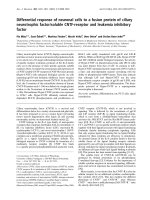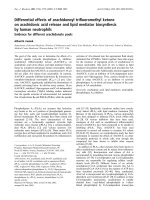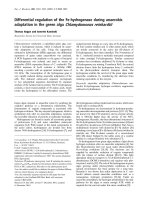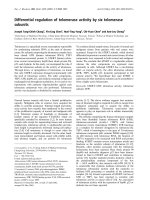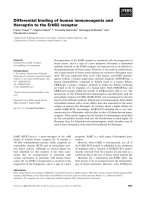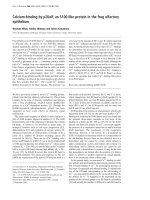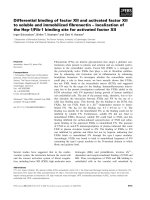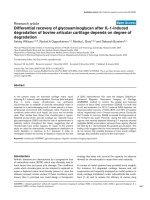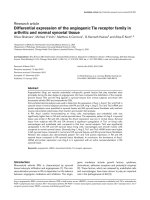Báo cáo y học: "Differential binding of chemokines to macrophages and neutrophils in the human inflamed synovium" pps
Bạn đang xem bản rút gọn của tài liệu. Xem và tải ngay bản đầy đủ của tài liệu tại đây (2.01 MB, 9 trang )
Research article
Differential binding of chemokines to macrophages and
neutrophils in the human inflamed synovium
Angela M Patterson, Caroline Schmutz, Scott Davis, Lucy Gardner, Brian A Ashton and Jim Middleton
Leopold Muller Arthritis Research Centre, Centre for Science and Technology in Medicine, Keele University at Robert Jones and Agnes Hunt
Orthopaedic Hospital, Oswestry, Shropshire, UK.
Correspondence: Dr Jim Middleton, LMARC, Robert Jones and Agnes Hunt Orthopaedic Hospital, Oswestry, Shropshire SY10 7AG, UK.
Tel: +44 (0)1691 404149; fax: +44 (0)1691 404170; e-mail:
Introduction
Rheumatoid arthritis (RA) is a chronic inflammatory
disease of the synovial joints, which can result in articular
cartilage and bone destruction, leading to significant dis-
ability. Central pathophysiological features of the disease
occur in the synovium, with thickening of the lining layer
(or intima) and infiltration of the sublining layer, mainly by
macrophages and lymphocytes [1]. In addition, the fluid-
filled joint cavity contains numerous neutrophils, particu-
larly during acute flares of RA [2].
The normal intima of the synovium is one to two cells thick
and consists mainly of macrophage-like and fibroblast-like
cells [3]. In inflammation, macrophages make a large con-
tribution to intimal thickening, where these cells increase
in number and proportion [3]. Evidence indicates that
Abstract
In chronic inflammatory foci, such as the rheumatoid joint, there is enhanced recruitment of phagocytes
from the blood into the tissues. Chemokines are strongly implicated in directing the migration of these
cells, although little is known regarding the chemokine receptors that could mediate their chemotaxis
into the joint tissue. Therefore the objective of the study was to identify chemokine binding sites on
macrophages and neutrophils within the rheumatoid synovium using radiolabeled ligand binding and in
situ autoradiography. Specific binding sites for CCL3 (macrophage inflammatory protein-1α), CCL5
(RANTES), CCL2 (monocyte chemoattractant protein-1) and CXCL8 (IL-8) were demonstrated on
CD68
+
macrophages in the subintimal and intimal layers. The number and percentage of intimal cells
that bound chemokines were greater in inflamed regions compared to noninflamed regions. The
intensity of intimal binding varied between chemokines with the rank order, CCL3 > CCL5 > CCL2 >
CXCL8. Neutrophils throughout the synovium bound CXCL8 but did not show any signal for binding
CCL2, CCL3 or CCL5.
Immunohistochemistry showed that both CXCR1 and CXCR2 are expressed by macrophages and
neutrophils in the rheumatoid and nonrheumatoid synovia, suggesting that both of these receptors are
responsible for the CXCL8 binding. The chemokine binding sites described on phagocytes may be
involved in the migration of these cells into the inflamed joint.
Keywords: chemokines, inflamed, receptors, synovium
Received: 30 March 2001
Revisions requested: 25 May 2001
Revisions received: 31 October 2001
Accepted: 12 December 2001
Published: 31 January 2002
Arthritis Res 2002, 4:209-214
This article may contain supplementary data which can only be found
online at />© 2002 Patterson et al., licensee BioMed Central Ltd
(
Print ISSN 1465-9905; Online ISSN 1465-9913)
CC = chemokine with two adjacent cysteine (C) residues near the NH
2
-terminus; CCR = CC chemokine receptor; CXC = chemokine with C sepa-
rated by an amino acid defined as X; CXCR = CXC chemokine receptor; IL = interleukin; PBS = phosphate-buffered saline; RA = rheumatoid arthri-
tis; RANTES = regulated on activation normal T cell expressed and secreted; rh = recombinant human.
Available online />Arthritis Research Vol 4 No 3 Patterson et al.
intimal macrophages arrive via the circulation as mono-
cytes [4], and it is proposed that increased numbers of
intimal macrophages in RA are largely attributed to
enhanced monocyte recruitment from blood vessels in the
synovium [1,5]. Neutrophils are also recruited in RA and
can be found in abundance in synovial fluid, yet they occur
in relatively low numbers in the synovium [5]. In synovial
fluid their number can reach 10
6
per joint, particularly
during an active phase of the disease [6]. Neutrophils
occur at the pannus-cartilage junction [7] and it is pre-
sumed that these cells reach the joint cavity by migrating
from the blood vessels in the synovium, following a
chemotactic gradient.
Chemokines are a family of proinflammatory cytokines,
which are strongly implicated in inducing migration of
leukocytes from the blood into inflammatory lesions.
Evidence has accumulated to suggest that chemokines,
such as CXCL8 (IL-8), CXCL5 (epithelial cell-derived
neutrophil-activating protein), CCL2 (monocyte chemo-
attractant protein-1), CCL3 (macrophage inflammatory
protein-1α) and CCL5 (RANTES), direct the migration of
leukocytes into the RA synovium and joint fluid [8].
Chemokines occur in significantly elevated levels in human
RA synovial fluid, where they are biologically active, and
are expressed by cells of the synovium and cartilage.
Tumour necrosis factor-α blockade reduces synovial
expression of CCL2 and CXCL8 and reduces inflamma-
tory cell migration into RA joints [9]. In addition, these
chemokines, produced by RA synovial stromal cells, have
been shown to stimulate monocyte migration [10]. The
functional importance of chemokines in joint inflammation
has also been established in animal models of RA where
antibodies to these mediators significantly reduce both the
number of leukocytes recruited and the severity of
disease. In addition, administration of chemokines to the
joints of animal models results in inflammation and leuko-
cyte recruitment.
The biological effects of chemokines are mediated by
binding to G-protein-coupled, seven transmembrane
domain, chemokine receptors [11]. CC receptors (CCR)
bind members of the class of chemokines with two adja-
cent cysteine (C) residues near the NH
2
-terminus (CC;
e.g. CCL2, CCL3 and CCL5) and CXC receptors
(CXCR) bind members of the class of chemokines with C
separated by an amino acid defined as X (CXC; e.g.
CXCL5 and CXCL8). There have been some reports on
the expression of such receptors on T cells in synovial
tissue and fluid [12–16]. Little is known about the expres-
sion of chemokine receptors on phagocytes in the human
RA synovium. One recent study has shown the protein
expression of several chemokine receptors on monocytes/
macrophages in RA blood, synovium and synovial fluid
[17]. The aim of the present study, therefore, was to
examine the expression of in situ chemokine binding sites
on macrophages and neutrophils that could mediate the
migration of these cells into the inflamed synovium.
Materials and methods
Tissue source
Tissue samples were obtained from patients with RA
(n = 6) who fulfilled the American Rheumatism Association
criteria for RA (Supplementary Table 1). Synovia were
taken from these subjects at total knee replacement
(patients 1, 3–5) or knee synovectomy operations (patients
2 and 6). Non-RA patients (n = 6) had knee joint symp-
toms for suspected articular cartilage, meniscal or anterior
cruciate ligament damage (patients 7–12). Knee joint syn-
ovial biopsies were obtained from these non-RA individu-
als, with informed consent, at arthroscopy. For RA and
non-RA patients, samples were taken from the suprapatel-
lar pouch and medial gutter, which is reported to provide
representative sampling of synovial membrane pathology
[18].
In situ
binding autoradiography
The method of Hub and Rot [19] was followed, with minor
modifications (see Supplementary Material).
Identification of macrophages and neutrophils
Representative sections of synovia that had been incu-
bated with
125
I-labeled chemokines were immunostained
for CD68 as a marker for macrophages. Slides were
deparafinized, rehydrated and treated with 1% pronase for
seven minutes at room temperature. Following blocking of
endogenous peroxidase, sections were treated with
normal horse serum and incubated with 2.5 µg/ml anti-
CD68 monoclonal antibody (PG-M1, Dako A/S, Glostrup,
Denmark) in PBS/normal horse serum. The bound anti-
body was detected using biotinylated second antibody,
avidin-peroxidase conjugate and diaminobenzidine sub-
strate (Vectastain ABC Elite Kit; Vector Labs, Burlingame,
USA). Slides were then coated with emulsion, exposed,
developed and stained in haematoxylin, as for in situ
binding autoradiography.
Neutrophils were identified by their characteristic multi-
lobed nuclei in haematoxylin and eosin stained sections.
Immunohistochemistry of CXCR1 and CXCR2
Synovial samples that had been examined for chemokine
binding were also sectioned and incubated with rabbit
polyclonal antibodies to the carboxy termini of CXCR1
and CXCR2 (both from Santa Cruz Biotechnology, Santa
Cruz, USA) [20]. Antibody binding was detected using an
immunoperoxidase method (Vectastain ABC Elite Kit;
Vector Labs, Burlingame, USA). See Supplementary
Material for more detailed methods.
Quantitation of synovial sections
See Supplementary Material.
Results
Tissue sampling
In all six RA subjects the histological appearance of
synovia showed classic inflammatory pathology with
mononuclear cell infiltrates and a thickened intimal layer. In
two of these individuals a minority of synovial samples also
showed microscopically normal regions with minimal infil-
tration of inflammatory cells and an intimal layer of normal
thickness (one to two cells thick). The synovia of the six
non-RA patients showed inflamed and noninflamed
regions. These inflamed regions displayed intimal layer
thickening and some infiltration of mononuclear cells,
although not as severe as in RA samples, and noninflamed
sites showed a normal intimal layer and no leukocyte infil-
trates.
Chemokine binding to macrophages
To examine in situ binding of chemokines, synovia were
treated with
125
I-CXCL8,
125
I-CCL2,
125
I-CCL3 and
125
I-
CCL5 followed by autoradiogaphy. For direct compari-
son, each chemokine was added at the same specific
radioactivity and concentration, and autoradiography
was performed for an identical exposure time. All four
chemokines bound to synovial tissue cells in the subin-
tima and the intima in every RA and non-RA individual
(Supplementary Fig. 1a for CCL5). Radiolabelled
chemokine binding was absent in synovia treated with
1000-fold excess homologous nonradiolabelled
chemokine, indicating that the binding sites were spe-
cific (Supplementary Fig. 1b). Histological examination
indicated that macrophages accounted for a high pro-
portion of the chemokine binding, so to confirm this
observation, representative sections were immunos-
tained with CD68 as a marker of monocytes/
macrophages, then processed for autoradiogaphy. All
four chemokines bound to CD68
+
cells in the subintima
in every RA and non-RA synovial sample. No major differ-
ences in chemokine binding were apparent between the
six RA patients, despite variation in disease duration and
drug treatment (Supplementary Table 1). The positive
cells were located close to blood vessels in leukocyte
infiltrates and non infiltrated sites, and in more remote
sites within the subintimal stroma (Fig. 1). In addition
CD68
+
macrophages bound all four chemokines in the
intimal layer of inflamed (Fig. 1) and noninflamed
samples. In control experiments there was no immunos-
taining when isotype-matched control mouse IgG was
used instead of the anti-CD68 antibody.
Quantitation of intimal binding
The number of intimal cells that bound chemokines were
counted and the results for RA and non-RA patients were
expressed as means (Table 1). There was a significant
increase of chemokine-positive cells in inflamed intima
compared to noninflamed intima, for both RA and non-RA
synovia. The number of positive cells varied between
chemokines and in RA tissue the rank order was, CCL3 >
CCL5 > CCL2 > CXCL8. In non-RA tissue the order
was, CCL3 > CCL5 > CXCL8 > CCL2. The number of
CCL3 and CCL5 positive intimal cells did not differ
between RA and non-RA tissue. However, the number of
intimal cells binding CCL2 in RA was greater than non-
RA synovium. In addition, there were more cells binding
CXCL8 in inflamed, non-RA intima compared to inflamed
RA tissue.
Data were also expressed as the percentage of intimal
cells binding chemokines (Supplementary Table 2). Similar
results to data expressed as the number of cells binding
chemokines were obtained (Table 1 and Supplementary
Table 2). In both RA and non-RA synovia there was a sig-
nificantly higher percentage of positive cells in inflamed
compared to noninflamed intima. The rank order of
Available online />Figure 1
Chemokine binding to CD68
+
monocyte/macrophages (red) in the
synovium. (a) CCL5 binding to CD68
+
cells around a venule in the
subintima of inflamed, nonrheumatoid synovium. (b) CXCL8 (IL-8)
binding to macrophages in a macrophage-rich infiltrate in rheumatoid
tissue. (c) CXCL8 binding to macrophages in a lymphocyte-rich
infiltrate in rheumatoid synovium. (d) CCL3 (macrophage inflammatory
protein-1α) binding to macrophages in the inflamed intimal layer of
rheumatoid synovium. Magnification ×470 (a)–(d).
chemokine binding was almost identical whether the data
were expressed as percentage or number of cells binding
chemokines. In the cases of CCL2, CCL3 and CCL5
there were no differences in the percentages of positive
cells between RA and non-RA tissue. A higher percentage
of cells, however, bound CXCL8 in non-RA inflamed
intima compared to RA inflamed intima.
Chemokine binding to neutrophils
Neutrophils were present in the synovia of four out of the
six RA patients, but they were less abundant than
mononuclear cells. Neutrophils were absent in non-
rheumatoid synovia. Neutrophils were positive for
125
I-
CXCL8 binding (Fig. 2) which was displaced in the
presence of 1000-fold excess nonradiolabelled
chemokine. These cells bound IL-8 in all locations within
the synovium: within blood vessels; close to blood vessels
in the extravascular tissue; and close to (or at) the intimal
surface. Neutrophils did not show any signal for binding
CCL2, CCL3 and CCL5 (Fig. 2). No major differences in
neutrophil chemokine binding were apparent between the
four patients who had these cells in their synovia.
Immunolocalisation of CXCR1 and CXCR2
To define the molecular identity of the
125
I-CXCL8 binding
sites on synovial macrophages and neutrophils, immuno-
histochemistry was performed to examine expression of
CXCR1 and CXCR2 by these cells. Sections from the
same blocks of synovia used for radiolabelled chemokine
binding were treated with antibodies to CXCR1, CXCR2
and CD68. Samples from every RA and non-RA patient
showed expression of both CXCR1 and CXCR2 by
macrophages in the subintima and intima (Supplementary
Fig. 2 and Fig. 3). Similarly, in RA samples that possessed
neutrophils, immunoreative CXCR1 and CXCR2 was dis-
played by these cells throughout the subintimal and intimal
layers; the staining intensity for CXCR2 was more strong
than for CXCR1 (Fig. 3c). Sections treated with rabbit IgG
instead of CXCR1 or CXCR2 were negative for
macrophage and neutrophil staining (Fig. 3d).
Discussion
The results of the present study show the presence of
chemokine binding sites on macrophages and neutrophils
Arthritis Research Vol 4 No 3 Patterson et al.
Table 1
The number of cells binding chemokines per 500
µµ
m of intima
Rheumatoid (n = 6) Nonrheumatoid (n = 6)
Chemokine Inflamed Noninflamed Inflamed Noninflamed
CXCL8 13 ± 1*
†
3 ± 1 22 ± 2* 5 ± 1
CCL2 23 ± 3*
†
10 ± 1
†
15 ± 3* 5 ± 1
CCL5 29 ± 2* 14 ± 3 25 ± 3* 10 ± 2
CCL3 33 ± 2 – 36 ± 3* 13 ± 2
The number of positive cells per standard length of intimal surface was counted (3360 µm total length per patient); data are expressed separately
for inflamed (>2 cells thick) and noninflamed tissue (1–2 cells thick). Data are expressed as mean ± SE. n, number of patients; *significant
difference between inflamed and noninflamed;
†
significant difference between rheumatoid and nonrheumatoid.
Figure 2
Chemokine binding to neutrophils in rheumatoid synovia. (a) CXCL8
binds to marginated neutrophils within a blood vessel. (b) CXCL8
binds to neutrophils in the subintimal tissue. There was a lack of
binding of CCL5 (c) and CCL3 (d) to neutrophils in the subintima.
Magnification ×470 (a)–(d).
in the RA synovium. These sites were evident around
blood vessels of the subintima, throughout the subintimal
stroma and in the intima. In RA there is increased recruit-
ment of monocytes, which migrate into the synovial subin-
tima and to the intima, presumably following a chemotactic
gradient [3]. The increase in synovial macrophage
numbers is mainly due to enhanced recruitment since
there appears to be little contribution from in situ prolifera-
tion of these cells [21], although deficient apoptosis may
have an effect on increasing cell number [1]. There is also
increased recruitment of neutrophils in RA, migrating from
subintimal venules, across the synovium and into the syn-
ovial fluid where they can occur in large numbers. The
binding of CCL2, CCL3, CCL5 and CXCL8 to
macrophages and CXCL8 binding to neutrophils suggests
that these receptors may be involved in signaling the
migration of the phagocytes through the RA synovium into
tissue microcompartments and fluid.
The finding that the proportion and percentage of
chemokine binding sites on macrophages increases in the
inflamed intima of RA and non-RA synovia suggests that
these receptors may function in chronic severe synovitis in
RA and more mild synovitis associated with joint damage/
degeneration in non-RA pathology. In the cases of CCL2,
CCL3 and CCL5 there were no differences in the per-
centage of chemokine-positive cells in inflamed regions of
the RA and non-RA intima. However, there were fewer
CXCL8 positive cells in the inflamed RA intima than in the
inflamed non-RA intima. The RA synovia were obtained
from patients with long-standing disease whereas the non-
RA samples were essentially from patients with joint symp-
toms of shorter duration (Supplementary Table 1). One
explanation is that there may be temporal changes in
chemokine receptor expression, which could explain this
difference between RA and non-RA CXCL8 binding. In
this respect, temporal changes in chemokine expression
have been reported in human RA and an animal model of
RA [22,23]. Alternatively the difference in CXCL8 binding
could relate to variation in inflammatory mechanisms or a
response to drug treatment in the RA group.
The present experimental approach was taken with the
aim of finding out if receptors on phagocytes bind
chemokines in situ, and showed that the receptors are
available and functional in terms of binding chemokines.
Our results agree with in situ studies in human skin, where
macrophages also express binding sites for radiolabelled
CCL3, CCL5 and CXCL8 [24,25]. The disadvantage with
the radioligand technique is the lack of definition regarding
the molecular nature of the receptors. In contrast, immuno-
histochemistry or flow cytometry have the advantage of
molecular identification, but can not show definitively if the
receptors bind ligands. Immunohistochemistry showed
that both CXCR1 and CXCR2 were expressed by synovial
macrophages and neutrophils, suggesting that the CXCL8
binding sites on these cells were CXCR1 and CXCR2.
A recent immunohistochemical study has shown the
presence of CCR1, CCR2 and CCR5 on CD68
+
Available online />Figure 3
Immunohistochemistry of CXCR2 in the synovium using
immunoperoxidase and diaminobenzidine (brown) staining. (a) Section
of rheumatoid synovium treated with a CXCR2 antibody. CXCR2 is
expressed on macrophages in the intima. (b) Adjacent section to (a)
treated with an anti-CD68 antibody. (c) CXCR2 is present in
neutrophils in the rheumatoid synovium. (d) There was a lack of
staining when sections were incubated with rabbit IgG instead of
CXCR1 or CXCR2. Magnification ×380 (a), (b) and (d); magnification
×470 (c).
macrophages in the RA synovium, but not CCR4 [17].
Since CCL2 is a ligand for CCR2, and both CCL3 and
CCL5 are ligands for both CCR1 and CCR5 [11], these
receptors are probably the CC chemokine binding sites
on the macrophages in the present study. The lack of
CCL2, CCL3 and CCL5 binding to synovial neutrophils
suggests little or no expression of the corresponding CC
chemokine receptors on these cells. This is in agreement
with other studies showing lack of CCL2 binding to blood
neutrophils and general lack of chemotactic response of
these cells to CC chemokines [26], although recent
reports indicate that neutrophils, in response to certain
cytokines, are capable of expressing CC chemokine
receptors [27,28].
Conclusion
This study demonstrates the expression of available
chemokine binding sites for CCL2, CCL3, CCL5 and
CXCL8 on CD68
+
macrophages in the subintimal and
intimal layers of rheumatoid and nonrheumatoid synovia.
Chemokine binding sites for CXCL8, but not for CCL2,
CCL3 or CCL5, were found on neutrophils in the rheuma-
toid synovium. These receptors may mediate the recruit-
ment of phagocytes to the subintima, intima or synovial
fluid and could provide potential therapeutic targets.
Acknowledgments
We gratefully acknowledge funding from the Droitwich Medical Trust
and Smith’s Charity, UK. We wish to thank the following surgeons for
their assistance in obtaining synovia: Mr C McGeoch, Mr D Rees, Mr L
van Niekerk and Mr S White. Acknowledgement is given to P Evans, N
Harness, M Pritchard and L Shaw for histological expertise. This work
was undertaken by the Robert Jones and Agnes Hunt Orthopaedic and
District Hospital NHS Trust, which receives a proportion of its funding
from the NHS Executive. The views expressed in this publication are
those of the authors.
References
1. Firestein GS: Rheumatoid synovitis and pannus. In Rheumatol-
ogy. Edited by Klippel JH, Dieppe PA. London: Mosby; 1998:
13.1-13.24.
2. Edwards SW, Hallet MB: Seeing the wood from the trees: the
forgotten role of neutrophils in rheumatoid arthritis. Immunol
Today 1997, 18:320-324.
3. Edwards JCW: The synovium. In Rheumatology. Edited by
Klippel JH, Dieppe PA. London: Mosby; 1998:6.1-6.8.
4. Edwards JCW, Willoughby DA: Demonstration of bone marrow
derived cells in synovial lining by means of giant intracellular
granules as genetic markers. Ann Rheum Dis 1982, 41:177-182.
5. Athanasou NA: Synovial macrophages. Ann Rheum Dis 1995,
54:392-394.
6. Hollingsworth JW, Siegel ER, Creasey WA: Granulocyte survival
in synovial exudate of patients with rheumatoid arthritis and
other inflammatory joint diseases. Yale J Biol Med 1967, 39:
289-296.
7. Mohr W, Menninger H: Polymorphonuclear granulocytes at the
pannus-cartilage junction in rheumatoid arthritis. Arthritis
Rheum 1980, 23:1413-1414.
8. Szekanecz Z, Strieter RM, Kunkel SL, Koch AE: Chemokines in
rheumatoid arthritis. Springer Semin Immunopathol 1998, 20:
115-132.
9. Taylor PC, Peters M, Paleolog E, Chapman PT, Elliot MJ,
McCloskey R, Feldman M, Maini RN: Reduction of chemokine
levels and leukocyte traffic to joints by tumor necrosis factor
αα
blockade in patients with rheumatoid arthritis. Arthritis
Rheum 2000, 43:38-47.
10. Hayashida K, Nanki T, Girschick H, Yavuz S, Ochi T, Lipsky P:
Synovial stromal cells from the rheumatoid arthritis patients
attract monocytes by producing MCP-1 and IL-8. Arthritis Res
2001, 3:118-126.
11. Horuk R: Chemokine receptors. Cytokine Growth Factor Rev
2001, 12:313-335.
12. Loetscher P, Uguccioni M, Bordoli L, Baggiolini M, Moser B, Chiz-
zolini C, Dayer J-M: CCR5 is characteristic of Th1 lymphocytes.
Nature 1998, 391:344-345.
13. Mack M, Bruhl H, Gruber R, Jaeger C, Cihak J, Eiter V, Plachy J,
Stangassinger M, Uhlig K, Schattenkirchner M, Schlondorff D:
Predominance of mononuclear cells expressing the
chemokine receptor CCR5 in synovial effusions of patients
with different forms of arthritis. Arthritis Rheum 1999, 42:981-
988.
14. Buckley CD, Amft N, Bradfield PE, Pilling D, Ross E, Arenzana-
seisdedos F, Amara A, Curnow SJ, Lord JM, Scheel-Toellner D,
Salmon M: Persistent induction of the chemokine receptor
CXCR4 by TGF-1 on synovial T cells contributes to their accu-
mulation within the rheumatoid synovium. J Immunol 2000,
165:3423-3429.
15. Nanki T, Hayashida K, El-gabalawy HS, Suson S, Shi K, Girschick
HJ, Yavuz S, Lipsky PE: Stromal cell-derived factor-1-CXC
chemokine receptor 4 interactions play a central role in CD4+
T cell accumulation in rheumatoid arthritis synovium. J
Immunol 2000, 165:6590-6598.
16. Nanki T, Lipsky PE: Cytokine, activation marker, and
chemokine receptor expression by individual CD4+ memory
cells in rheumatoid arthritis synovium. Arthritis Res 2000, 2:
415-423.
17. Katschke KJ, Rottman JB, Ruth JH, Qin S, Wu L, LaRosa G,
Ponath P, Park CC, Pope RM, Koch AE: Differential expression
of chemokine receptors on peripheral blood, synovial fluid,
and synovial tissue monocytes/macrophages in rheumatoid
arthritis. Arthritis Rheum 2001, 44:1022-1032.
18. Kirkham B, Portek I, Lee CS, Stavros B, Lenarczyk A, Lassere M,
Edmonds J: Intraarticular variability of synovial membrane his-
tology, immunohistology, and cytokine mRNA expression in
patients with rheumatoid arthritis. J Rheumatol 1999, 26:777-
784.
19. Hub E, Rot A: Methods for study of chemokine receptors in
the tissues. Methods 1996, 10:119-125.
20. Addison CL, Daniel TO, Burdick MD, Liu H, Ehlert JE, Xue YY,
Buechi L, Walz A, Richmond A, Strieter RM: The CXC
chemokine receptor 2, CXCR2, is the putative receptor for
ELR+ CXC chemokine-induced angiogenic activity. J Immunol
2000, 165:5269-5277.
21. Ceponis A, Kontinnen YT, Imai S, Tamulaitiene M, Li TF, Xu JW,
Hietanen J, Santavirta S, Fassbender HG: Synovial lining,
endothelial and inflammatory mononuclear proliferation in
synovial membranes in psoriatic and reactive arthritis: a com-
parative quantitative morphometric study. Br J Rheumatol
1998, 37:170-178.
22. Szekanecz Z, Halloran MM, Volin M, Woods JM, Strieter RM,
Haines K, Kunkel S, Burdick MD, Koch AE: Temporal expression
of inflammatory cytokines and chemokines in rat adjuvant-
induced arthritis. Arthritis Rheum 2000, 43:1266-1277.
23. Katrib A, Tak PP, Bertouch JV, Cuello C, McNeil HP, Smeets TJM,
Kraan MC, Youssef PP: Disease duration and the expression
of chemokines and matrix metalloproteinases in rheumatoid
arthritis. Arthritis Rheum 2000, 43(suppl):S84.
24. Rot A: Binding of neutrophil attractant/activation protein-1
(interleukin-8) to resident dermal cells. Cytokine 1992, 4:347-
352.
25. Hub E, Rot A: Binding of RANTES, MCP-1, MCP-3 and MIP-1
αα
to cells in human skin. Am J Pathol 1998, 152:749-757.
26. Baggiolini M, Dewald B, Moser B: Interleukin-8 and related
chemotactic cytokines - CXC and CC chemokines. Adv
Immunol 1994, 55:97-179.
27. Bonecchi R, Polentarutti N, Luini W, Borsatti A, Bernasconi S,
Locati M, Power C, Proudfoot A, Wells TNC, Mackay C, Manto-
vani A, Sozzano S: Up-regulation of CCR1 and CCR3 and
induction of chemotaxis to CC chemokines by IFN-
γγ
in human
neutrophils. J Immunol 1999, 162:474-479.
28. Cheng SS, Lai JJ, Lukacs NW, Kunkel SL: Granulocyte-
macrophage colony stimulating factor up-regulates CCR1 in
human neutrophils. J Immunol 2001, 166:1178-1184.
Arthritis Research Vol 4 No 3 Patterson et al.
Supplementary material
Supplementary Materials and methods
In situ
binding autoradiography
Synovia were cut into approximately 2 mm
3
pieces. Four
samples were placed in tubes containing 0.1 to 4.0 ng of
recombinant human
125
I-labeled (rh
125
I)-CXCL8 (M
r
=
8400), rh
125
I-CCL5 (M
r
= 8000), rh
125
I-CCL2 (M
r
=
8800) or rh
125
I-CCL3 (M
r
= 8000) (262 µCi/µg; NEN,
Boston, USA) in 400 µl Hank’s balanced salt solution con-
taining 0.1% bovine serum albumin and 20 mM HEPES.
The samples were then incubated for one hour at room
temperature on a platform shaker [19]. In these experi-
ments, synovial samples from each patient were treated
with each of the four chemokines. Initial experiments
showed that binding sites were saturable over this con-
centration-RAnge and the optimum binding/background
ratio was obtained using 0.8 ng of chemokine; this amount
was used in all the subsequent experiments. Control tubes
contained 1000-fold excess of the corresponding unla-
beled recombinant human chemokine (molecular mass as
for radiolabelled chemokines) (PeproTech EC, London,
UK; CXCL8 was kindly donated from Novartis Research
Institute, Vienna, Austria). The tissue was washed four
times for 10 min in 2 ml Hank’s balanced salt solution on a
platform shaker, then fixed overnight in 4% paraformalde-
hyde. It was then dehydrated in alcohol, embedded in
fibrowax and sectioned at 5 µm thickness. Sections were
deparafinized, rehydrated, air-dried and coated with Amer-
sham LM1 emulsion (Amersham Pharmacia Biotech, Little
Chalfont, UK). The slides were exposed at 4°C for two
weeks, developed and stained in haematoxylin and eosin.
Immunohistochemistry for CXCR1 and CXCR2
Sections were deparafinized, rehydrated and in the case of
CXCR1 pre-treated with 1% pronase for 10 min to unmask
epitopes. Following blocking of endogenous peroxidase
with 0.3% hydrogen peroxide in methanol for 30 min, slides
were rinsed in PBS and treated with a 1/60 dilution of
normal goat serum for 30 min. Sections were rinsed in
PBS, incubated with CXCR1 or CXCR2 antibodies (at
1/50 and 1/500 dilution respectively) or rabbit IgG (at the
same concentration as primary antibodies) for 30 min. After
washing with PBS, the antibodies were detected using
reagents in the Vectastain ABC Elite Kit (Vector Labs,
Burlingame, USA); the sections were treated with biotiny-
lated goat anti-rabbit IgG (at 1/200 dilution) for 30 min,
rinsed with PBS, incubated with streptavidin-conjugated
peroxidase for 30 min, washed with PBS, then treated with
the chromogen 3,3′-diaminobenzidine for 5 min. Sections
were washed twice in PBS then water, dried and counter-
stained in Mayer’s haematoxylin. All steps in the method
were carried out at room temperature.
Quantitation of synovial sections
Sections were used from in situ binding autoradiography
experiments and were quantitated blind by one observer.
The sample length was 280 µm of synovial intima, the
width of a field of view using a ×63 objective lens on a
Nikon diaplan light microscope. Intimal cells were scored
as being positive for chemokine binding when the autora-
diographic signal was greater than that of the adjacent
background. The number of positive and negative cells
were counted visually in three sample lengths per section
(i.e. 840 µm). The number of sections per patient was
Available online />Supplementary Table 1
Details of RA and non-RA patients
Gender Age Diagnosis/pathology Disease duration (years) Medication
1. Female 71 RA 7 An
2. Male 61 RA 20 St
3. Female 67 RA 7 St, NSAID
4. Male 73 RA 15 Pen, NSAID, An
5. Female 52 RA 20 Hyd, St, MTX, Gold, NSAID
6. Female 56 RA 25 –
7. Female 47 articular cartilage damage 5 –
8. Male 43 acl damage <1 –
9. Male 46 meniscal tear, articular cartilage damage 7 –
10. Female 46 meniscal tear, articular cartilage degeneration <1 NSAID
11. Female 63 meniscal tear, articular cartilage degeneration <1 –
12. Male 43 acl and articular cartilage damage >5 –
acl, anterior cruciate ligament; An, analgesic; Hyd, Hydroxychloroquine; MTX, methotrexate; NSAID, non-steroidal anti-inflammatory drug; Pen,
penicillamine; RA, rheumatoid arthritis; St, steroid.
four, giving a total of 3360 µm of intima measured per
patient. The intima was noted as being normal where it
was one to two cells thick, and inflamed where greater
than two cells thick. All cells were counted except neu-
trophils, which only comprised <1% of all cells sampled.
From these data, the number and percentage of positive
cells in the intimal samples were obtained and expressed
per 500 µm of intima. Statistical analyses were by Studen-
t’s t-test, The result was significant when P < 0.05.
Supplementary Discussion
The functional role of chemokine receptors in inflammatory
cell recruitment is suggested from animal models of RA.
Using the CC chemokine receptor antagonist MCP-1(9-
76), a truncated analogue peptide corresponding to MCP,
markedly reduces joint histopathology and symptoms in
the MRL-lpr mouse model [S1]. The CC receptor antago-
nist MetRANTES decreased the incidence and severity of
arthritis in mouse collagen-induced arthritis [S2]. With
both antagonists, mononuclear infiltration is reduced.
CCL2, CCL3, CCL5 and CXCL8 occur in human RA syn-
ovial fluid and tissue [8]. Therefore the ligands for the
binding sites described here occur endogenously within
the RA joint, adding further evidence towards a role for
these receptors in vivo. In the RA joint the synovial
macrophage is among the principle cell types that
produce CCL2, CCL3 and CXCL8 [8,17]. The finding of
chemokine receptors on these cells suggests that
macrophages may amplify inflammation by attracting cells
of the same type, and other cell types, into the joint
Arthritis Research Vol 4 No 3 Patterson et al.
Supplementary Figure 1
In situ receptor autoradiography showing chemokine binding to the
inflamed nonrheumatoid synovium. (a) Samples of tissue were
incubated with
125
I-CCL5 and subjected to autoradiography. The
chemokine binds to cells in the intima (I) and the subintima (S). (b)
Samples incubated with radiolabelled chemokine in the presence of
1000-fold excess homologous unlabelled chemokine show an absence
of chemokine binding. Magnification ×470 (a) and (b).
Supplementary Figure 2
CXCR1 immunohistochemistry of the synovium using
immunoperoxidase and diaminobenzidine (brown) staining. (a) Section
of a macrophage-rich infiltrate in a rheumatoid synovium treated with a
CXCR1 antibody. (b) Adjacent section to (a) treated with an anti-
CD68 antibody as a macrophage marker. Note the presence of
CXCR1 on macrophages. Magnification ×380 (a) and (b).
thereby setting up a positive feedback loop. Similar mech-
anisms may also be occurring with neutrophils, since in
the RA joint these cells produce CXCL8 [S3] and express
CXCL8 binding sites.
Supplementary References
S1. Gong J-H, Ratkay LG, Waterfield JD, Clark-Lewis I: An antagonist
of monocyte chemoattractant protein 1(MCP-1) inhibits arthri-
tis in the MRL-lpr mouse model. J Exp Med 1997, 186:131-
137.
S2. Plater-Zyberk C, Hoogewerf AJ, Proudfoot AEI, Power CA, Wells
TNC: Effect of a CC chemokine receptor antagonist on colla-
gen induced arthritis in DBA/1 mice. Immunol Lett 1997,
57:117-120.
S3. Beaulieu A, McColl S: Differential expression of two major
cytokines produced by neutrophils, interleukin-8 and the
interleukin-1 receptor antagonist, in neutrophils isolated from
synovial fluid and peripheral blood of patients with rheuma-
toid arthritis. Arthritis Rheum 1994, 37:855-859.
Available online />Supplementary Table 2
Percentage of intimal cells binding chemokines per 500
µµ
m of intima
Rheumatoid (n = 6) Nonrheumatoid (n = 6)
Cytokine Inflamed Noninflamed Inflamed Noninflamed
CXCL8 42 ± 5 *
†
13 ± 4 58 ± 5 * 17 ± 2
CCL2 56 ± 5 * 27 ± 3 48 ± 7 * 19 ± 3
CCL5 79 ± 3 * 49 ± 11 66 ± 7 * 33 ± 7
CCL3 88 ± 2 – 87 ± 5 * 44 ± 6
The number of positive cells per standard length of intimal surface was counted (3360 µm total length per patient); data are expressed separately
for inflamed (>2 cells thick) and noninflamed tissue (1–2 cells thick). Data are expressed as mean ± SE. n, number of patients. *Significant
difference between inflamed and noninflamed;
†
significant difference between rheumatoid and nonrheumatoid.
